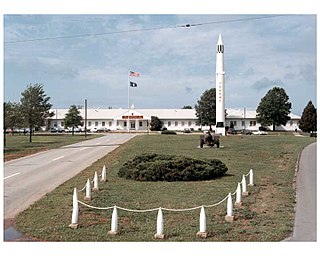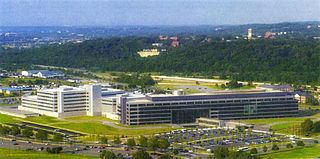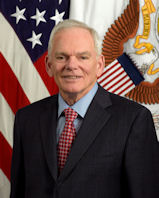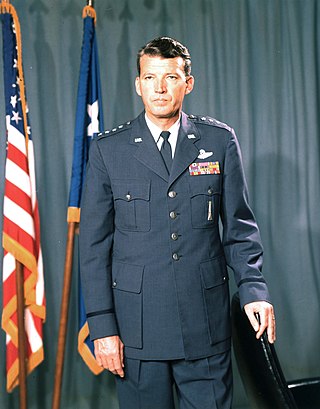
The Ballistic Missile Defense Organization (BMDO) was an agency of the United States Department of Defense that began on 20 May 1974 with the responsibility for all U.S. ballistic missile defense efforts. It was renamed the Missile Defense Agency in 2002.

The Defense Intelligence Agency (DIA) is an intelligence agency and combat support agency of the United States Department of Defense, specializing in defense and military intelligence.

Redstone Arsenal (RSA) is a United States Army post and a census-designated place (CDP) adjacent to Huntsville in Madison County, Alabama, United States and is part of the Huntsville-Decatur Combined Statistical Area. The Arsenal is a garrison for various tenants across the Department of Defense, Department of Justice, and NASA. RSA has benefited from decisions by the Defense Base Realignment and Closure Commission. The Redstone Arsenal CDP had a residential population of 837 as of the 2020 census. The base contains a government and contractor workforce that averages 36,000 to 40,000 personnel daily.

The MGM-140 Army Tactical Missile System (ATACMS) is a tactical ballistic missile manufactured by the US defense company Lockheed Martin. It has a range of up to 190 miles (300 km), with solid propellant, and is 13 feet (4.0 m) high and 24 inches (610 mm) in diameter. The ATACMS can be fired from the tracked M270 Multiple Launch Rocket System (MLRS), and the wheeled M142 High Mobility Artillery Rocket System (HIMARS).

The Army Ballistic Missile Agency (ABMA) was formed to develop the U.S. Army's first large ballistic missile. The agency was established at Redstone Arsenal on 1 February 1956, and commanded by Major General John B. Medaris with Wernher von Braun as technical director.

The PGM-11 Redstone was the first large American ballistic missile. A short-range ballistic missile (SRBM), it was in active service with the United States Army in West Germany from June 1958 to June 1964 as part of NATO's Cold War defense of Western Europe. It was the first US missile to carry a live nuclear warhead, in the 1958 Pacific Ocean weapons test, Hardtack Teak.

The United States Space Command is a unified combatant command of the United States Department of Defense, responsible for military operations in outer space, specifically all operations 100 kilometers and greater above mean sea level. U.S. Space Command is responsible for the operational employment of space forces that are provided by the uniformed services of the Department of Defense.

The United States Army Space and Missile Defense Command (USASMDC) is an Army Service Component Command (ASCC) of the United States Army. The command was established in 1997. The current USASMDC commander is Lieutenant General Daniel L. Karbler with Senior Enlisted Advisor Command Sergeant Major John W. Foley.

The United States Army Aviation and Missile Command (AMCOM) develops, acquires, fields and sustains aviation, missile and unmanned aerial vehicles. AMCOM is primarily responsible for lifecycle management of army missile, helicopter, unmanned ground vehicle and unmanned aerial vehicle weapon system. The central part of AMCOM's mission involves ensuring readiness through acquisition and sustainment support for aviation systems, missile systems, and test, measurement, and diagnostic equipment (TMDE) throughout their life cycle. The command is headquartered at Redstone Arsenal in Huntsville, Alabama, has a 2019 "budget of more $3.7 billion, and a global workforce of more than 15,000 military and civilian employees".

The United States Strategic Command (USSTRATCOM) is one of the eleven unified combatant commands in the United States Department of Defense. Headquartered at Offutt Air Force Base, Nebraska, USSTRATCOM is responsible for strategic nuclear deterrence, global strike, and operating the Defense Department's Global Information Grid. It also provides a host of capabilities to support the other combatant commands, including integrated missile defense; and global command, control, communications, computers, intelligence, surveillance, and reconnaissance (C4ISR). This command exists to give "national leadership a unified resource for greater understanding of specific threats around the world and the means to respond to those threats rapidly".

The U.S. Army Combat Capabilities Development Command Aviation & Missile Center (AvMC), formerly known as the U.S. Army Aviation and Missile Research, Development and Engineering Center (AMRDEC), a part of the U.S. Army Research, Development, and Engineering Command (RDECOM) — now DEVCOM, is primarily a civilian organization tasked to provide research, development and engineering technology and services to support U.S. Army aviation and missile platforms. AvMC conducts research, promotes development, engineering and simulation laboratories and facilities used to develop and improve aviation and missile components, subsystems and systems.

The Defense Intelligence Agency Headquarters is the main operating center of the Defense Intelligence Agency. It is located on the premises of Joint Base Anacostia–Bolling in Washington, D.C.

The Redstone Test Stand or Interim Test Stand was used to develop and test fire the Redstone missile, Jupiter-C sounding rocket, Juno I launch vehicle and Mercury-Redstone launch vehicle. It was declared an Alabama Historic Civil Engineering Landmark in 1979 and a National Historic Landmark in 1985. It is located at NASA's George C. Marshall Space Flight Center (MSFC) in Huntsville, Alabama on the Redstone Arsenal, designated Building 4665. The Redstone missile was the first missile to detonate a nuclear weapon. Jupiter-C launched to test components for the Jupiter missile. Juno I put the first American satellite Explorer 1 into orbit. Mercury Redstone carried the first American astronaut Alan Shepard into space. The Redstone earned the name "Old Reliable" because of this facility and the improvements it made possible.

Patrick M. Hughes is a retired United States Army officer who served as the 12th Director of the Defense Intelligence Agency (DIA). Previously, he was Director of Intelligence for the US Joint Chiefs of Staff from 1994 to 1996 and the Director of Intelligence at United States Central Command from 1992 to 1994. He was the Commanding General, United States Army Intelligence Agency, and the Assistant Deputy Chief of Staff for Intelligence, U.S. Army from 1990 until 1992. He joined the United States Department of Homeland Security in 2003 as the Assistant Secretary for Information Analysis (Intelligence), and departed from DHS and Government service in March 2005.
Carl Ernest Duckett was the founder of the Central Intelligence Agency's science and technology operations.

Malcolm Ross O'Neill was the United States Assistant Secretary of the Army for Acquisition, Logistics, and Technology, having been sworn into office by United States Under Secretary of the Army Joseph W. Westphal on March 10, 2010, and resigned June 3, 2011.
William Ames "Bill" Davis Jr. was an engineer and distinguished leader in Ballistic Missile Defense (BMD) for the United States Army at Redstone Arsenal in Huntsville, Alabama. Davis was an inaugural member of the United States Senior Executive Service (SES) and recipient of numerous accolades and awards from the army, including the Meritorious Civilian Service Award (1980) and the Department of the Army Decoration for Exceptional Civilian Service (1982).

Rutledge Parker "Hap" Hazzard was director of Science and Technology division of Central Intelligence Agency (CIA) from 1973 to 1978. He became director of the National Photographic Interpretation Center (NPIC) in 1978. After serving six years as director of NPIC from June 1978 to February 1984, Hazzard returned to the CIA's National Intelligence Office. He retired from public service in 1985.

While the United States Space Force gained its independence on 20 December 2019, the history of the United States Space Force can be traced back to the beginnings of the military space program following the conclusion of the Second World War in 1945. Early military space development was begun within the United States Army Air Forces by General Henry H. Arnold, who identified space as a crucial military arena decades before the first spaceflight. Gaining its independence from the Army on 18 September 1947, the United States Air Force began development of military space and ballistic missile programs, while also competing with the United States Army and United States Navy for the space mission.

Juanita M. Christensen is an American government official and electronics engineer. She is the deputy chief of staff for logistics (G4) of facilities and environmental at the United States Army Materiel Command. From November 2017 until January 2021, Christensen was director of the United States Army Aviation and Missile Center. In February 2015, she became the first African-American woman from Redstone Arsenal to join the Senior Executive Service.




















